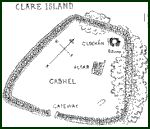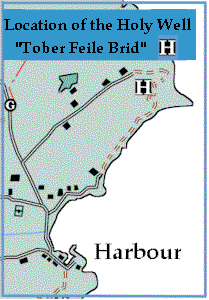| 1. Symposia / Historical Safaris
3. Research 4. Surveys
7. Folklore 9. Contact us 11. Links |
Early Christian monuments on Clare Island 1. Holy wells
The 'well of Mary's feast' lies to the north in a marshy field behind the Abbey and is in an even greater state of neglect now, than when Westropp commented on its state eighty years ago in the Clare Island Survey Archaeology section.. There are the remains of a well,covered by a shapeless heap of slabs, and about 5 metres to the east the outline of an alter can be discerned. Near the alter is the outline of a levelled enclosure, about 13 metres by 12metres in size. Westropp noted three dedicatory slabs left on the remains of the alter. We have not been able to locate any of these. One of the slabs had a Maltese cross and an English inscription from 1701. Westropp considered this most curious. A second slab, dated 1790, was also inscribed in English. Perhaps the most interesting aspect of Tober Feile Mhuire is its location in relation to the Abbey and graveyard enclosure. It is not unlikely that the first proselytizers for Christianity settled on this location because of its earlier connection with a Druidic site. The holy well was dedicated to the Blessed Virgin and a thousand years later, with a church built and rebuilt and ruined, and a new church built and Christianity firmly rooted, the new site could be enclosed with a wall to the exclusion of the ancient holywell.
Tober Feile Bhrid is to be found in the townland of Capnagower, eastward from the harbour, past the Hotel, in a bushy hollow above the mutable boulder-beach of Kinnacorra. There is a small pond formed in the hollow of the V. Nestling on a slope above this pond is Tober Feile Bhrid. It is a serene and beautiful location for a place of worship. We know of no-one today who makes regular pilgrimage to Tober Feile Bhrid, not even on the island itself. Westropp, writing eighty years ago, remarks that the repute of Cliara's Tober Feile Bhrid spread from Galway to Sligo to America. He writes: "observances on August 15th (Lady-Day in Harvest) take the form of 'rounds', the worshippers walking seven times sunward (i.e. with the right hand next the wall), round and just outside the cashel or enclosure. After this they go on their bare knees seven times round the labba and altar inside it, emerging by a gap in the north wall, and finishing by prayers at the well." Westropp records two significant cures as told to him, one of a young boy who slept on the labba while his mother did the rounds, and another of an invalid from Ballinrobe who, having heard of the fame of the well, spent a week on the island,drinking from the well and peforming regular rounds. The boy was cured of a limp and the man had his health restored. Granuaile,or Grace O'Malley,is also connected by legend to theTober. She is said to have married a shipwrecked sailor at the altar by the well. Her young husband was later killed by the MacMahons of Ballycroy who were in turn, at a later date, put under a curse for killing a man in Achill. Grace, who bided her time to avenge the wrong, heard that the MacMahons were to make a pilgrimage to Caher to purge the curse. Grace manned her galleys and hid behind the island until the MacMahons had landed. She managed to capture he rhusband's slayer, bring him to Clare Island and hang him there. Westropp considered the remains "very primitive and interesting." There is a dry-stone cashel forming an irregular quadrilateral with rounded corners, about 15 meters by16 meters.photo St.Brigid's bed, Leaba Brighdhe, is about 1 metre from the wall in the north-east corner. The Labba is a small stone structure built like a beehive hut about 3 meters in diameter. The interior is about 1.5 meters across and is sunken like a shallow well. The Altar is another 2 meters to the south. The well itself lies in a marsh about 6 meters from the north-east corner of the cashel. Tradition says that the well harbours a holy fish, a mysterious trout, only to be seen by the most devout pilgrims.
|
 There are two main holy sites on the island.
Clare Island Abbey and the nearby holy well of ToberFeile Mhuire, are to be found in the
townland of Cille, about two kilometers from the harbour, along the main east-west running
road on the island. The other site is a holy well lying in splendid isolation at the
easternmost point of the island, over looking the headland of Kinnacorra.
There are two main holy sites on the island.
Clare Island Abbey and the nearby holy well of ToberFeile Mhuire, are to be found in the
townland of Cille, about two kilometers from the harbour, along the main east-west running
road on the island. The other site is a holy well lying in splendid isolation at the
easternmost point of the island, over looking the headland of Kinnacorra. 
